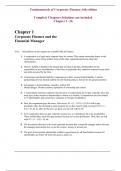Exam (elaborations)
Solutions for Fundamentals of Corporate Finance, 6th edition by Jonathan Berk
- Course
- Institution
Complete Solutions Manual for Fundamentals of Corporate Finance, 6th edition 6e by Jonathan Berk, Peter DeMarzo, Jarrad Harford. Full Chapters Solutions are included - Chapter 1 to 26 PART 1: INTRODUCTION Corporate Finance and the Financial Manager Introduction to Financial Statement Analysis ...
[Show more]



